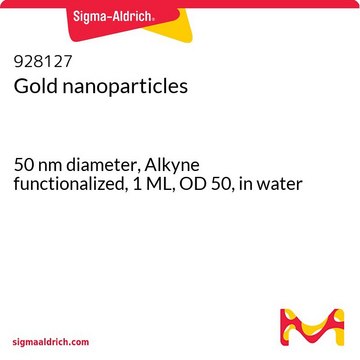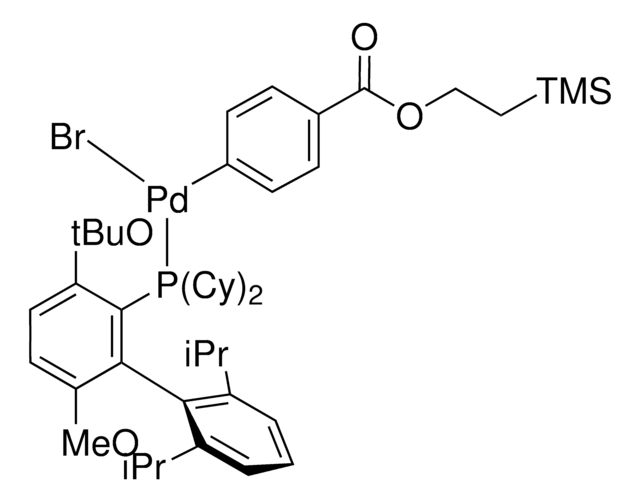추천 제품
일반 설명
Gold nanoparticles (AuNPs) ranging from 2-200nm in diameter find applications in diverse fields.They show excellent biocompatibility and attractive physicochemical properties. AuNPs, as aggregates, is shown to be highly sensitive colloidal biosensors. Poly (ethylene) glycol (PEG) surface coating on gold nanoparticles helps in the reduction of protein adsorption, reduces nonspecific interactions with cells and greatly improves the pharmokinetics of these nanoparticles and disables aggregation of the nanoparticles. PEG layer density depends inversely on the AuNP curvature. Denser coating is possible on smaller AuNPs. AuNPs coated with PEG 5000 exhibited highest colloidal stability. The methyl group, being hydrophobic acts as a protecting shield between the gold nanoparticles and the hydrophilic outer PEG coating and also leads to a further reduction of protein adsorption and macrophage uptake by the AuNPs.
애플리케이션
Several other specific applications have been listed below:
- Since they adhere to cell membranes, AuNPs may find use in cellular and intracellular targeting in targeted drug delivery applications and may also used in biodistribution studies.
- AuNPs may also be used in photothermal therapy and radiotherapy.
- AuNPs ranging from 10 to 250 nm, were studied to have been absorbed primarily by liver and spleen , when injected intravenously in rats.Whereas, 10 nm nanoparticles were distributed more broadly into various organs.
- Studies show that 30-nm PEG-coated AuNPs have been successfully used to deliver tumor necrosis factor to solid tumors.
Functionalized Particles have been extensively used to study cellular uptake of nanoparticles and targeted drug delivery.
특징 및 장점
PEG decreases the cytotoxicity and increases efficiency of GNPs in targeted drug delivery. PEG increases the stability of the nanoparticles and prevents agglomeration. Forms complexes easily with dyes and thiol ligands.
Storage Class Code
12 - Non Combustible Liquids
WGK
WGK 1
Flash Point (°F)
Not applicable
Flash Point (°C)
Not applicable
Xiao-Dong Zhang et al.
International journal of nanomedicine, 6, 2071-2081 (2011-10-07)
Gold nanoparticle toxicity research is currently leading towards the in vivo experiment. Most toxicology data show that the surface chemistry and physical dimensions of gold nanoparticles play an important role in toxicity. Here, we present the in vivo toxicity of
Timothy A Larson et al.
ACS nano, 6(10), 9182-9190 (2012-09-27)
Polyethylene glycol (PEG) surface coatings are widely used to render stealth properties to nanoparticles in biological applications. There is abundant literature on the benefits of PEG coatings and their ability to reduce protein adsorption, to diminish nonspecific interactions with cells
Functionalized gold nanoparticles and their biomedical applications
Tiwari, P. M., Vig, K., Dennis, V. A., & Singh, S. R.
Nanomaterials, 1(1), 31-63 (2011)
Cheng-Kuan Su et al.
Journal of chromatography. A, 1402, 1-7 (2015-05-26)
The extravasation of administered nano-drug carriers is a critical process for determining their distributions in target and non-target organs, as well as their pharmaceutical efficacies and side effects. To evaluate the extravasation behavior of gold nanoparticles (AuNPs), currently the most
문서
The recent emergence of a number of highly functional nanomaterials has enabled new approaches to the understanding, diagnosis, and treatment of cancer.
Biomaterials science involves the design and fabrication of smart materials for studying, directing, or mimicking biology. For successful integration of biomaterials in biological research, a meaningful understanding of biological systems is required.
자사의 과학자팀은 생명 과학, 재료 과학, 화학 합성, 크로마토그래피, 분석 및 기타 많은 영역을 포함한 모든 과학 분야에 경험이 있습니다..
고객지원팀으로 연락바랍니다.






